A few weeks ago, I mentioned here that I’d finished and successfully delivered to my Saturday morning Italian class an oral presentation on my recent trip to Italy. And when I suggested that I might share the written version of that presentation here (with an English translation), a few of you were kind enough to say you’d be interested in reading it.
And since some of you are, like me, keen to read in Italian when you find the opportunity, I’ve divided my travel account into sections and in each section I’ve provided the Italian text first. Then, as Georgia suggested in the comments to that earlier post, I’ve placed a photograph before I offer my English translation, so that she and other readers “can’t absorb [the English] while reading” the Italian. So if you’d like to read the Italian first, read the text (in italics) before each photo; if you want to skip straight to the English, you’ll find that after each photo.
Okay, here goes. Pretend I’m standing at the head of a long table and you’re sitting at a chair along its sides. I take a long breath, then look directly at you, smile, say Buon Giorno, and begin. . . .
È difficile raccontare un viaggio di cinque settimane in meno di quindici minuti. Ho pensato di parlare solamente del cibo, perché davvero il cibo è una chiave importante a capire l’Italia.
Ho anche pensato di parlare delle gente – la donna, per esempio, in un negozio speciale a Roma, che mi ha aiutato scegliere una penna stilografica . . . e poi ci ha consigliato un ristorante per pranzo. Il vecchio con cui ho chiacchierato un po’ quando sono stata separata da mio marito negli stretti vicoli tortuosi di Ortigia. . . anche lui ci ha consigliato . . . di stare insieme perché i vicoli sono come un labirinto. . . il venditore a Palermo che, dopo averci consegnato le nostre borse piene di frutta e verdura, ci ha regalato un’arancia scelta con cura. Forse perché abbiamo comprato un sacco di cose ma forse anche perché abbiamo fatto una bella chiacchierata su come preparare fava e carciofi.
Anche la possibilità di parlare dell’arte e dell’architettura che ci hanno cosi ben impressionati – le esibizioni delle sculture contemporanee di Jago a Roma o dei cani dell’opera di Velasco Vitali “Il Branco” contra la Mafia, a Palermo.
Tante, tante cose che vorrei condividere con voi.
Ma, davvero, c’è un orologio e devo scegliere e ho deciso di organizzare la mia presentazione per parlare di tre luoghi in cui ho soggiornato in Sicilia: Ortigia, Palermo, e Regaleali.
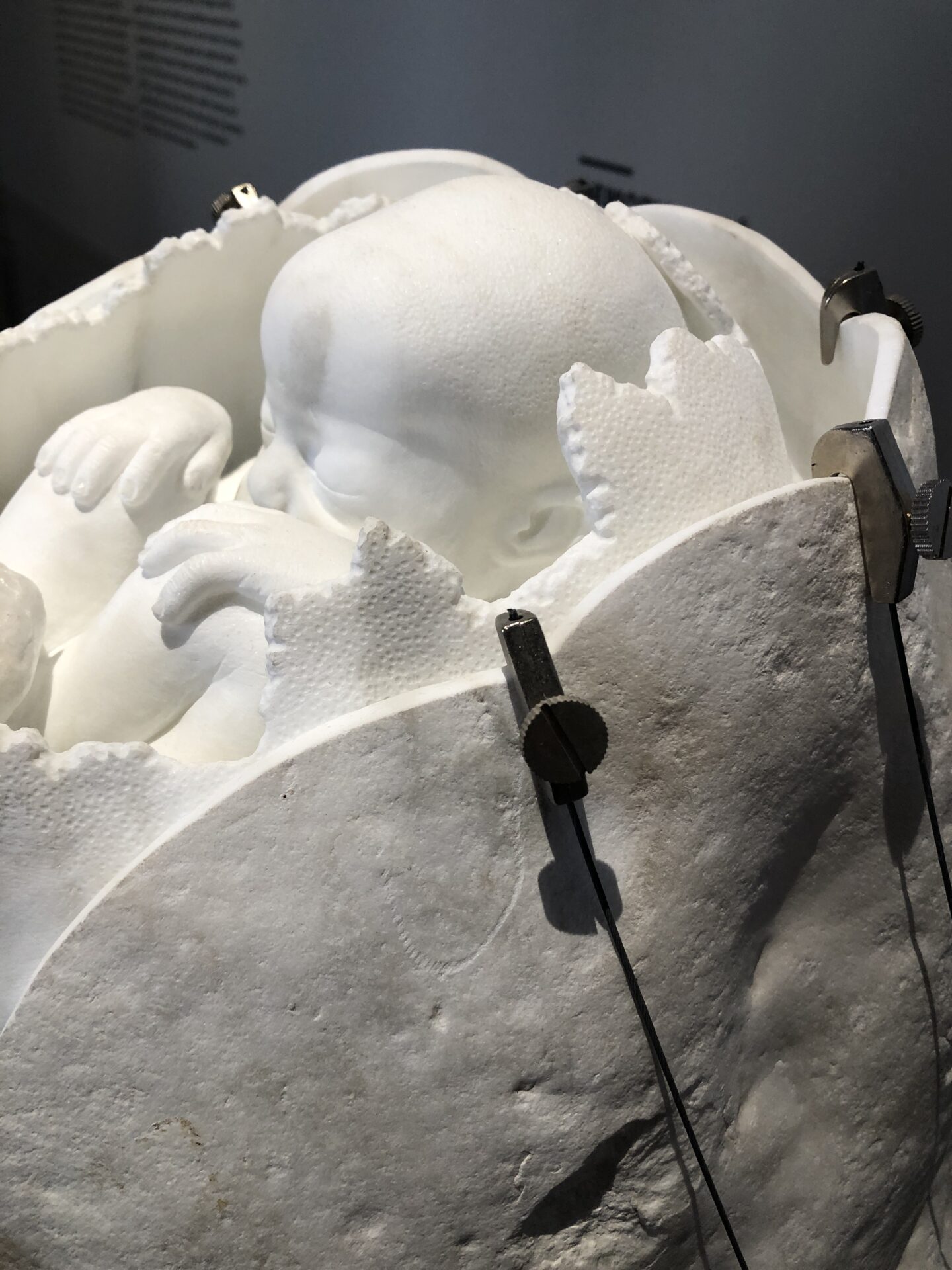
English translation (original Italian text is above the photo):
It’s difficult to sum up, in less than fifteen minutes, a trip that took five weeks. I thought of speaking only about the food, because, truly, food is an important key to understanding Italy.
I thought also about speaking of the people — the woman, for example, who helped me choose, in a special store in Rome, a fountain pen . . . and then advised us on a restaurant for our lunch. The old man with whom I chatted a bit when I was separated from my husband in the narrow winding alleys of Ortigia . . . he had advice as well . . . to stay together because the alleys were like a labyrinth. The vendor in Palermo who, after having handed us our bags full of fruit and vegetables, gifted us a carefully chosen orange. Perhaps because we had bought a lot, but also perhaps because we had had a good chit-chat about how to prepare the fava beans and artichokes we’d bought.
Also, the possibility of speaking about the art and architecture that impressed us so much — the exhibitions of Jago’s contemporary sculpture in Rome or the dogs of Velasco Vitali’s work, The Pack, against the Mafia, in Palermo.
So many, many things that I would like to share with you.
But, really, there’s a clock and I have to choose and I’ve decided to organize my presentation to speak of three places in which I stayed while in Sicilia: Ortigia, Palermo, e Regaleali.
Come i Greci 800 anni avanti Christo, siamo arrivati in Sicilia a Ortigia – ma non in nave come i Greci. Abbiamo preso il treno da Roma (un viaggio di 11 ore e una corsa in traghetto) e poi siamo andati a piedi dalla stazione di Siracusa attraverso il ponte per Ortigia. Perché Ortigia, la città vecchia, il cuore di Siracusa è un’isola. E su quest’isola c’è acqua dolce – la cosiddetta “fonte Aretusa” – la ragione per cui i Greci hanno deciso di costruire qui un insediamento.
Ortigia è una città bella che sì apre al mare – come si apre la finestra della nostra camera in un albergo dolce e semplice. . .. ma anche una città dall’interno più privato, di stradine tortuose piene di ombre . . . che all’improvviso si aprono su una piazza ampia e vivace, piena di luce solare e bambini che giocano e vecchi seduti a parlare e giovani donne che ammirano gioielli in una vetrina.Abbiamo trascorso tre giorni a Ortigia – abbiamo mangiato benissimo, abbiamo camminati molti chilometri, e io ho scattato moltissime foto! Abbiamo visto la Fonte d’Aretusa, il teatro greco e il teatro romano, la grotta che Caravaggio ha chiamato l’Orecchio di Dionisio (perché il tiranno avrebbe usato le sue proprietà acustiche per origliare e trovare cosi le prove che fosse stato tradito), l’Ara di Ierone dove migliaia di animali furono sacrificati, il più grande altare conosciuto nell’antichità.
Ma sebbene l’Ortigia sia molto bella, è anche segnata da molto decadimento e abbandono. Ci sono molti edifici che necessitano molte riparazioni con i cartelli A Vendersi. E ovunque si vedono i segni dei danni dell’aria salmastra, del mare e della forza schiarente del sole. Ringhiere arrugginite, cemento e intonaco fatiscenti, finestre rotte, marciapiedi e strade con instabilità e buche. . . questo decadimento serve a sottolineare la bellezza dei secoli– che può essere visto nella sua forma più raffinata nell’architettura barocca siciliana. Si può vedere nel Duomo – che conserva tracce anche di un tempio greco antico (delle colonne corinzie), una moschea costruita allo stesso sito, e la chiesa cattolica che ha incorporato questi primi edifici. La bellezza, le culture, le storie dei secoli, di oltre due milenni.
Ma anche, bisogna ammettere che questo decadimento serve a sottolineare molti decenni – no, secoli! – di malgoverno e difficoltà economiche. . . .
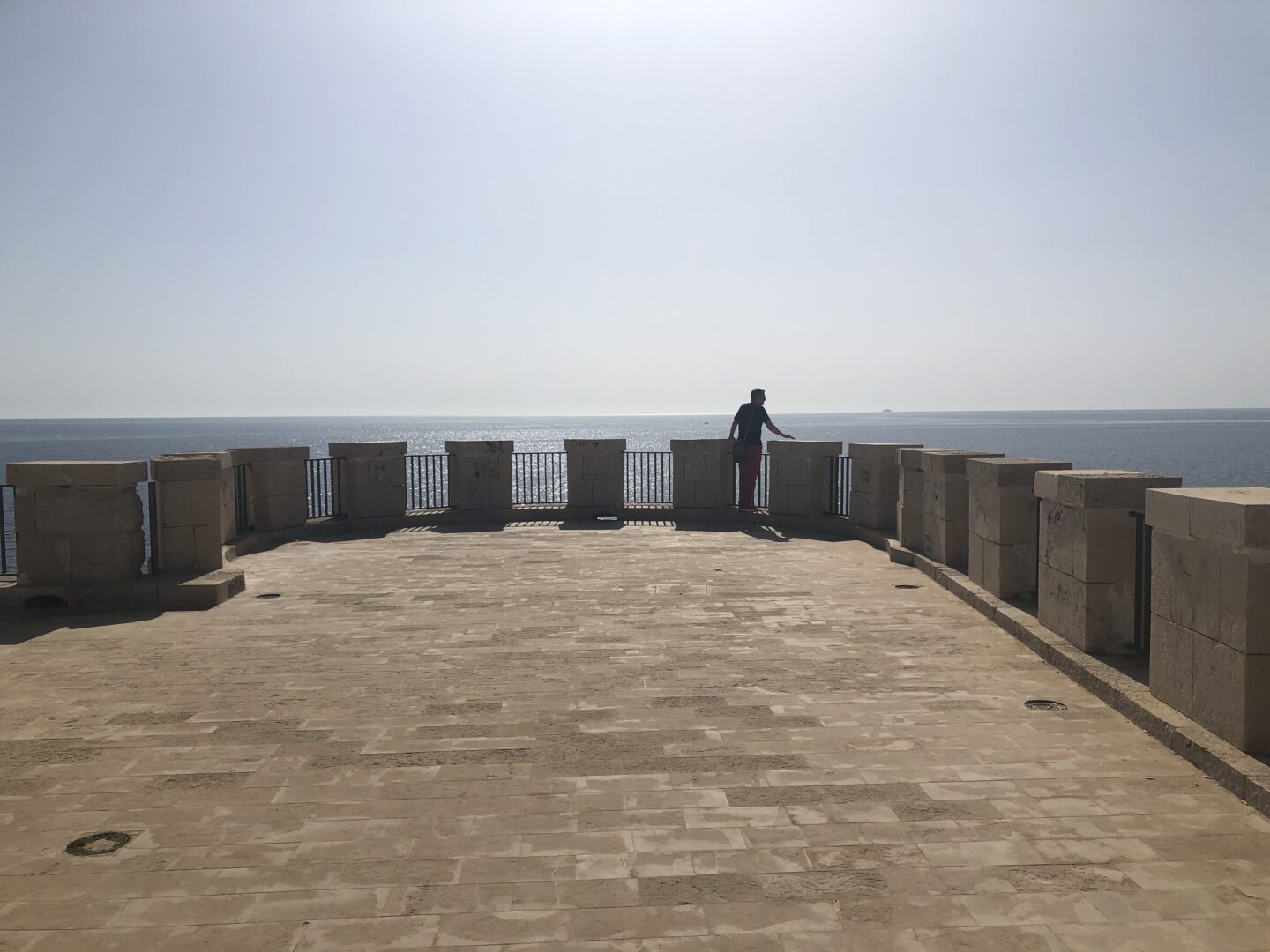
English translation of the original Italian text (italicized above):
Like the Greeks 800 years BC, we arrived in Sicilia at Ortigia — but not in boats as the Greeks did. We took the train from Rome (an 11-hour trip that included a ferry crossing) and then we went by foot from the Siracusa station across the bridge to Ortigia. Because Ortigia, the old city, the heart of Siracusa, is an island. And on this island there’s fresh water — the so-called Source (Spring) of Arethusa — the reason the Greeks decided to build a settlement here.
Ortigia is a beautiful city that opens onto the sea — like the window of our room in a sweet, simple hotel. . . . but it’s also a city with a more private interior, of narrow, winding streets full of shadows . . . that suddenly open onto an expansive and lively plaza, full of sunlight and children playing and old men sitting and talking and young woman admiring jewelry in a shoop window.
We spent three days in Ortigia — we ate very well, we walked many kilometres, and I snapped many, many photos. We saw Arethusa’s Spring, the Greek theatre and the Roman theatre, the cave that Caravaggio called The Ear of Dionysius (because the tyrant would use its acoustic properties to eavesdrop and thus find evidence that he had been betrayed), the Altar of Hieron where thousands of animals were sacrificed, the largest altar known from antiquity.
But as much as Ortigia is very beautiful, it’s also marked by much decay and neglect. There are many buildings needing many repairs with For Sale signs. And everywhere can be seen signs of the damage done by the salt air, by the sea, and by the bleaching power of the sun. Rusted railings, crumbling concrete and plaster, broken windows, buckling and pot-holed sidewalks and streets . . . this decay highlights the beauty of the centuries — that can be seen in the more refined Baroque Sicilian architecture. It can be seen in the Cathedral — that even preserves traces of an ancient Greek temple (some Corinthian columns), a mosque built on the same site, and the Catholic church that has incorporated these first buildings. The beauty, the cultures, the stories of centuries, of more than two millennia.
But also, it must be admitted that this decay serves to underline many decades — no, centuries — of poor government and economic difficulties.
Da Ortigia abbiamo preso il treno per Palermo (cambiando a Catania).
Cavolo! Appeno usciti dalla stazione, ci siamo resi conto che Palermo era diversa da qualsiasi altra città che avessimo mai visitato (la più simile, forse, sarebbe Napoli). Era rumorosa e caotica, e, bisogna ammettere, sporca – e molto vivace! La gente camminava per le strade tanto quanto sui marciapiedi. Le Vespe ronzavano tra la folla, spesso guidate da ragazzini, forse di 13 o 14 anni. C’erano meravigliosi edifici molto antichi, ma molti di loro erano in rovina. Come a Ortigia, ovunque c’erano segni di antica grandezza insieme con segni di decenni di difficoltà economiche – e probabilmente anche problemi politici e sociali.
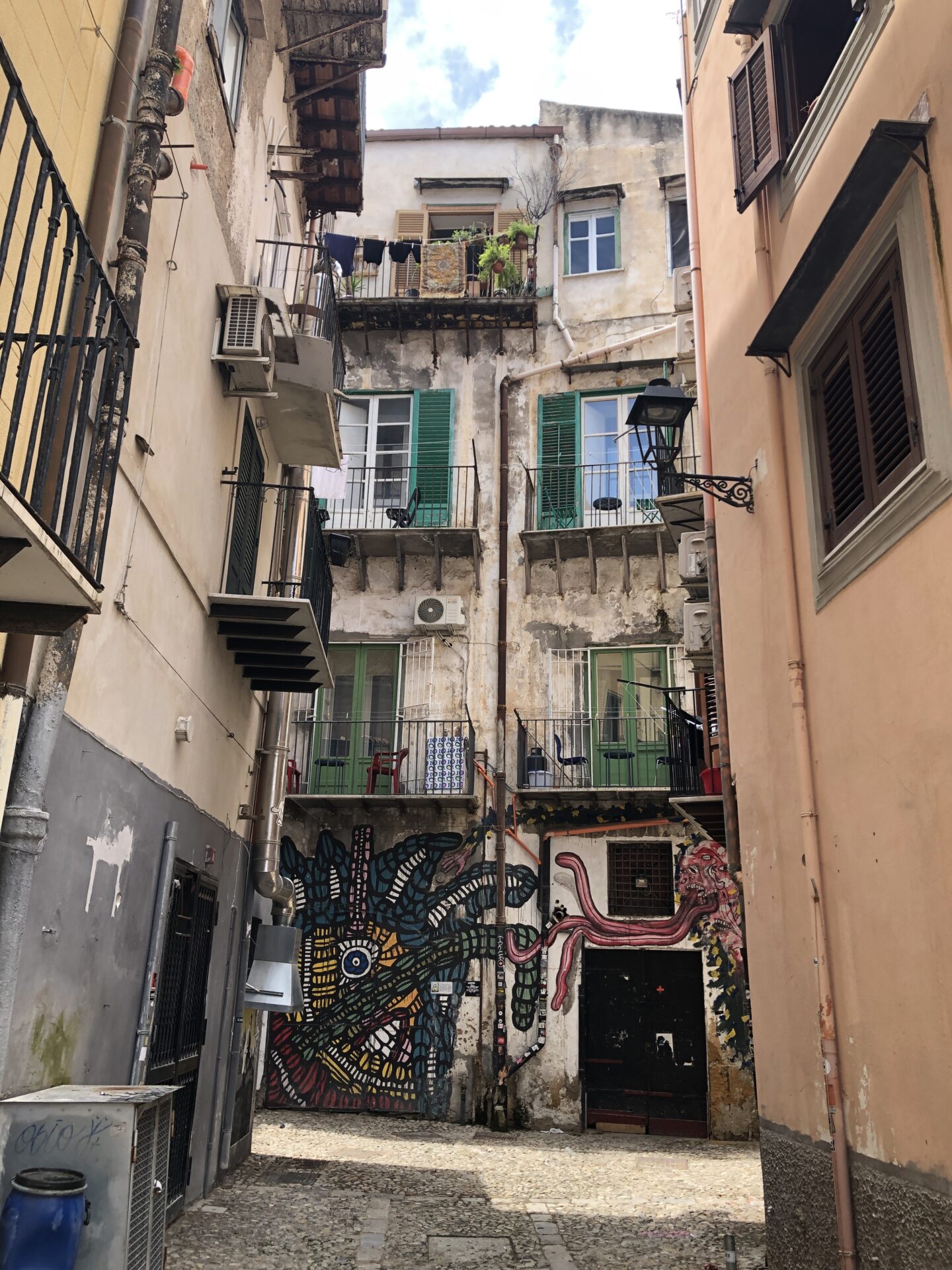
From Ortigia we took the train to Palermo (changing at Catania).
Oh my gosh! Barely out of the station, we realized that Palermo was different from any other city that we have ever visited (the most similar, maybe, would be Naples). It was noisy and chaotic, and, it must be admitted, dirty — and very lively! People walked on the streets as much as on the sidewalks. Vespa bikes buzzed through the crowd, often driven by kids, maybe 13 or 14 years old. There were marvellous buildings, very old, but many of them were in ruins. As in Ortigia, everywhere there were signs of ancient grandeur together with signs of decades of economic difficulties — and probably also political and social problems.
Momenti salienti e punti di riferimento favoriti della nostra visita a Palermo – i miei Bullet Points
— La Fontana Pretoria (anche chiamata La Fontana della Vergogna) – dall’Alto Rinascimento (fine 1500) commissionata, progettata e costruita a Firenze . . . ma quando è stato finita, il cliente non aveva abbastanza soldi per pagare. Quindi, il Senato palermitano acquistò la grandiosa scultura e la fece trasferire da Firenze a Palermo, Per farle spazio hanno abbattuto diversi edifici . . . è molto impressionante, con le sue numerose (più di 50!) creature grottesche e mitiche, e anche per la sua immensità.
— Vicino c’è un’altra piazza – Quattro Canti, dove si incrociano Via Maqueda e Corso Vittorio Emmanuele – e anche dove si incontrano quattro antichi cantoni (o quartieri) . . . Ad ogni angolo c’è una fontana molto ornata – mi ha ricordato le “quattro fontane” a Roma.
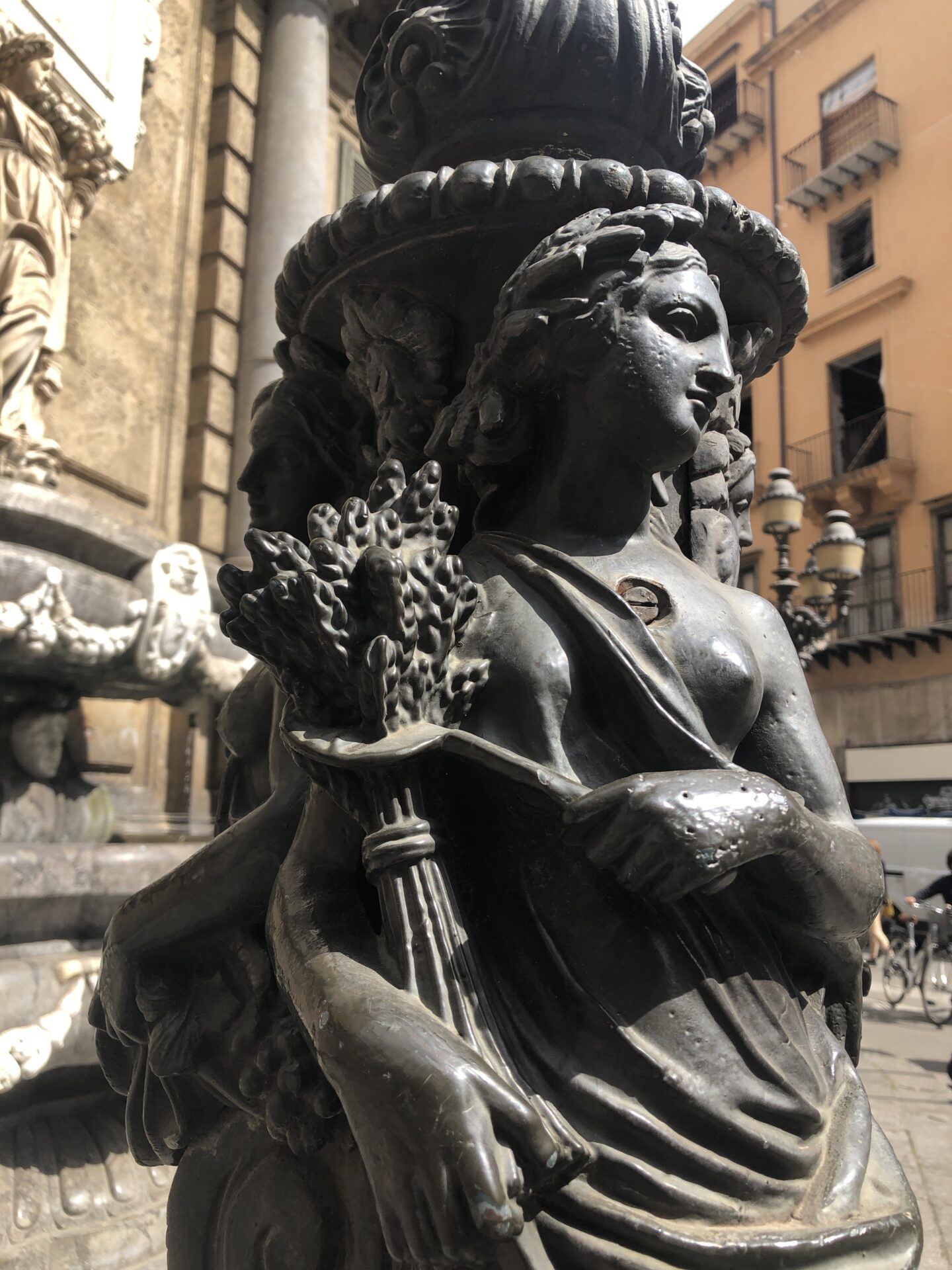
Highlights and Landmarks of our Palermo Visit — My Bullet Points
— The Pretoria Fountain (also called The Fountain of Shame) — from the High Renaissance (late 1500s) commissioned, designed, and built in Florence . . . but when it was finished, the client couldn’t afford to pay for it. So the Palermitan Senate acquired the grandiose sculpture and had it moved from Florence to Palermo. To make space for it, they had to demolish several buildings . . . It’s very impressive, with its numerous (more than 50!) grotesque and mythical creatures, and also for its immensity!
— Nearby there’s another plaza — Quattro Canti (Four Corners), where Via Maqueda and Corso Vittorio Emmanuele intersect, and also where four ancient neighbourhoods meet. At each corner, there’s a very ornate fountain. It reminded me of the Quattro Fontane (Four Fountains) in Rome.
— Arte che testimonia la continua lotta alla Mafia. . . Un enorme murale raffigurante Giovanni Falcone e Paolo Borsellino sul fianco di un edificio vicino al porto turistico; i 54 cani (– si chiamano “Il Branco”) dello scultore Velasco Vitali – i cani sparsi per tutta la facoltà di Giurisprudenza dell’Università di Palermo, una meditazione sul Bene e sul Male nel contesto della Mafia; la scultura astratta di Giovanna di Sanctis (due ali giganti) composta in bronzo, che rappresenta Nike – (dea della vittoria) in Piazza della Memoria (dedicata a quegli operatori della giustizia uccisi dalla mafia) di fronte ai monumentali Palazzi di Giustizi . . . molto, molto commovente!
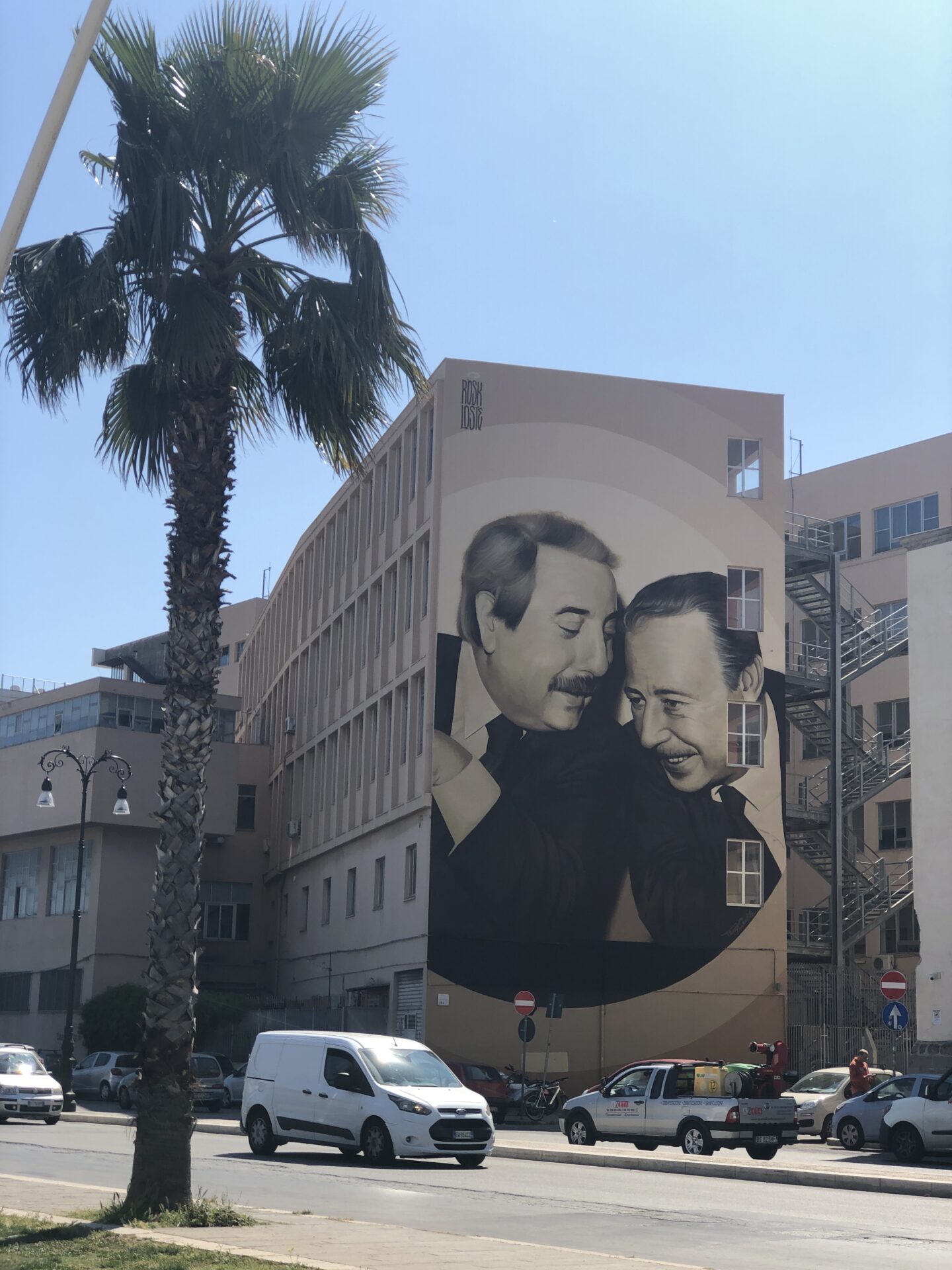
–Art that testifies to the ongoing fight against the Mafia: An enormous mural representing Giovanni Falcone and Paolo Borsellino on the side of a building near the waterfront; the 54 dogs (called “The Pack”) of sculptor Velasco Vitali, the dogs scattered throughout the Faculty of Law at the University of Law at the University of Palermo. . . a meditation on Good and Evil in the context of the Mafia; the abstract bronze sculpture of Giovanna di Sanctis (two gigantic wings) that represents Nike (goddess of Victory) in the Plaza of Memory (dedicated to those justice works killed by the Mafia) in front of the monumental Law Courts . . . very, very moving!
— Un lungomare e un porto turistico (acqua frizzante, cieli azzurri, tutte le barche bianche e blu) bello e vivace, che si sono trasformati gradualmente nel corso degli anni come parte dell’approccio progressisto del sindaco Leoluca Orlando – ho scoperto che Orlando ha sfidato l’approcio repressivo del governo Italiano nei confronti dei rifugiati (particolarmente i rifugiati africani) . . . . Posso parlare più di questo, ma l’orologio . . .
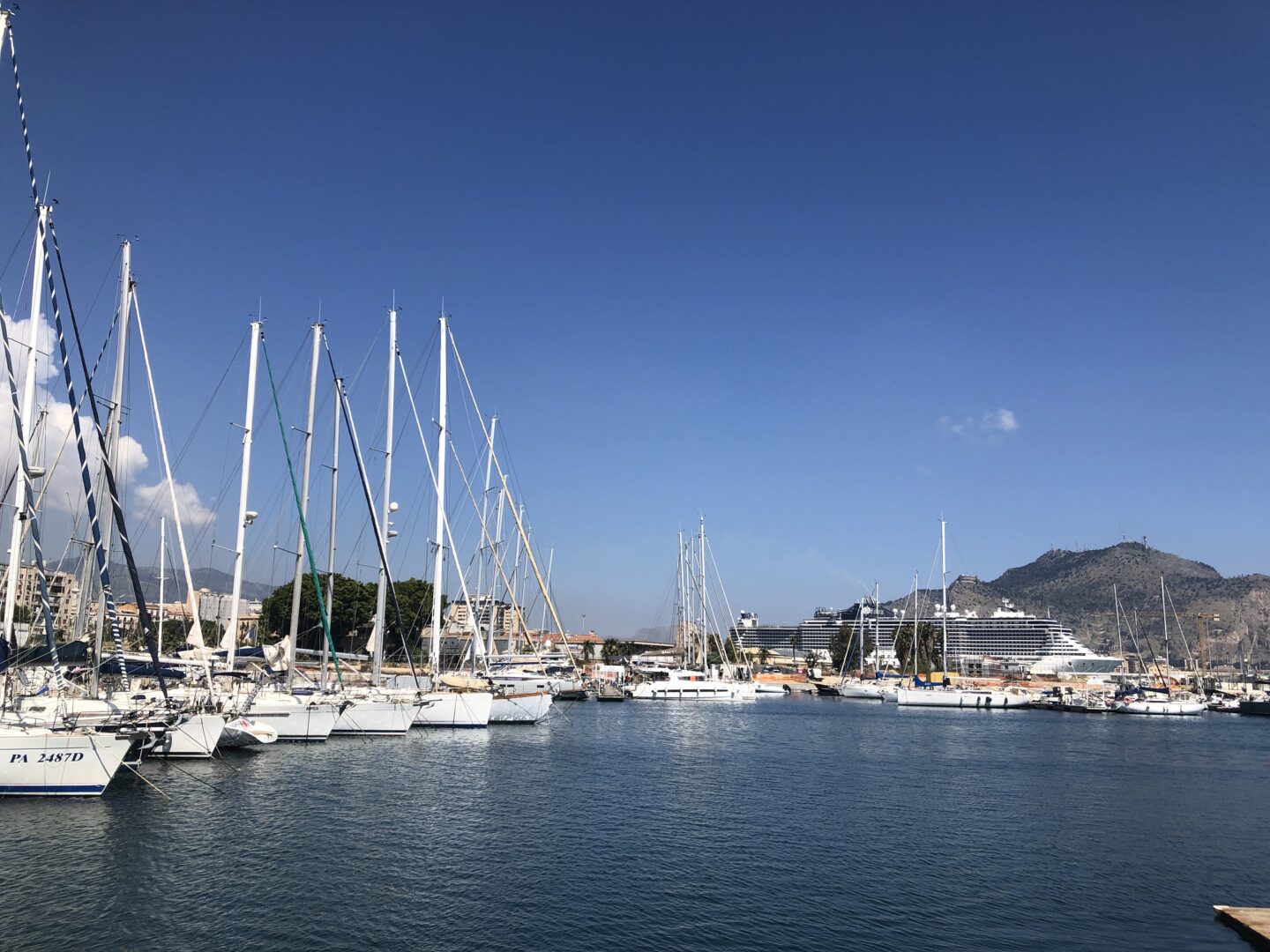
— A seawall walk and a beautiful, lively tourist port (sparkling water, blue skies, all the blue and white boats), that is being transformed gradually over the years as part of Mayor Leoluca Orlando’s progressive policies. I discovered that Orlando defied the repressive approach of the Italian government toward refugees (particularly African refugees) . . . I could speak more of this, but the clock . . .
— L’Orto Botanico: Una tregua meravigliosamente tranquilla e ombreggiata dal caldo e dai rumori dalla città – con molti interessanti esempi di alberi, arbusti, cactus, piante perenni, ecc. – e un gigantesco Ficus Macrophylla con le sue strane radici aeree . . . e c’è una biblioteca botanica che piacerà sicuramente agli amanti dei libri.
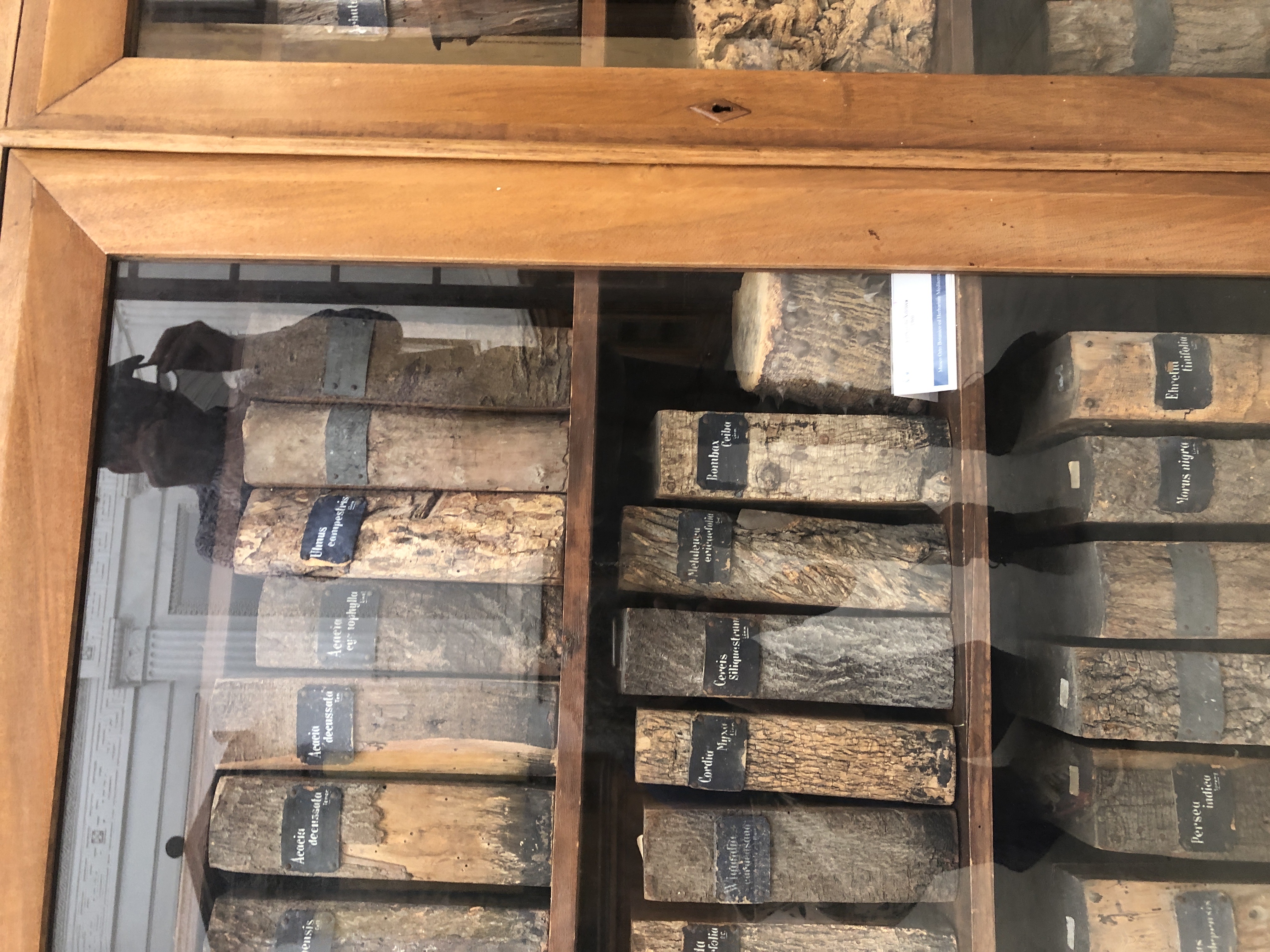
— The Botanic Garden — A wonderfully tranquil and shady retreat from the heat and noises of the city — with many interesting examples of trees, shrubs, cacti, herbaceous perennials, etc. And a gigantic Ficus Macrophylla (Moreton Bay Fig) with its strange aerial roots . . . and there’s a botanic library that will surely please book lovers.
— La donna un po’ vecchia (come me) chi mi ha insegnato a prendere una “brioche” con la mia granita e di intingerla nella dolce bevanda ghiacciata come i palermitani—e dopo averla portata al nostro tavolo, mi ha stretto affettuosamente il braccio e poi mi ha accarezzato le guance – credo che l’abbia fatto perché mi ero sforzata di parlarle in italiano.
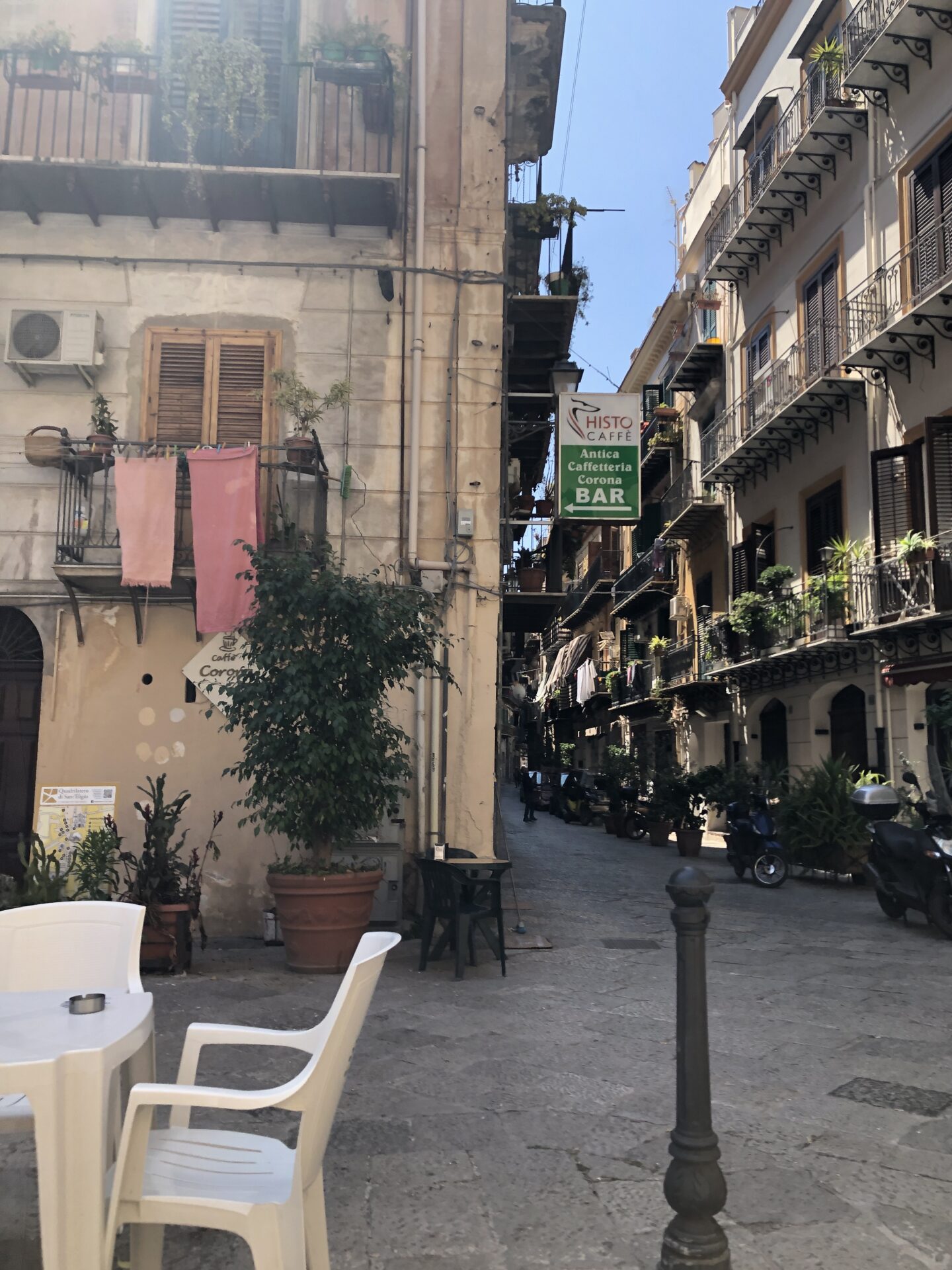
— The older woman (about my age) who taught me to order a brioche with my granita and to dip it in the sweet frozen drink like the Palermitans. And after she brought the drink to our table, squeezed my arm affectionately and then patted my cheeks — I believe she did that because I had made the effort to speak to her in Italian.
Parlando di queste due città – Ortigia e Palermo – ci è voluto talmente tanto tempo che non ce n’è più per parlarvi di Regaleali. Forse basta chiedervi di immaginarvi una bellissima campagna di dolci colline. Trovarsi nell’entroterra rurale della Sicilia è molto diverso che trovarsi in una frenetica città costiera. Ovunque un verde ricco tranne che per le distese di papaveri rossi o di sulla rosa o i fiori viola e rosa dei piselli selvatici. Ovunque, il canto degli uccelli, dei galli . . . il tubare delle colombe, spesso il suono delle campane delle chiese lontane, a volte dei campanacci delle pecore. Ovunque, filare e filare di viti. Un casale e edifici annessi che racchiudono tutti un ampio cortile a cui siamo entrati attraverso un enorme cancello in ferro battuto. . . e dove io e dodici altre donne disegnavamo insieme ammirando la bellezza intorno a noi . . . e cercavamo di catturarne una piccola parte nei nostri taccuini. E dove cucinavamo e mangiavamo bene il cibo che veniva dalla terra che ci circondavamo.
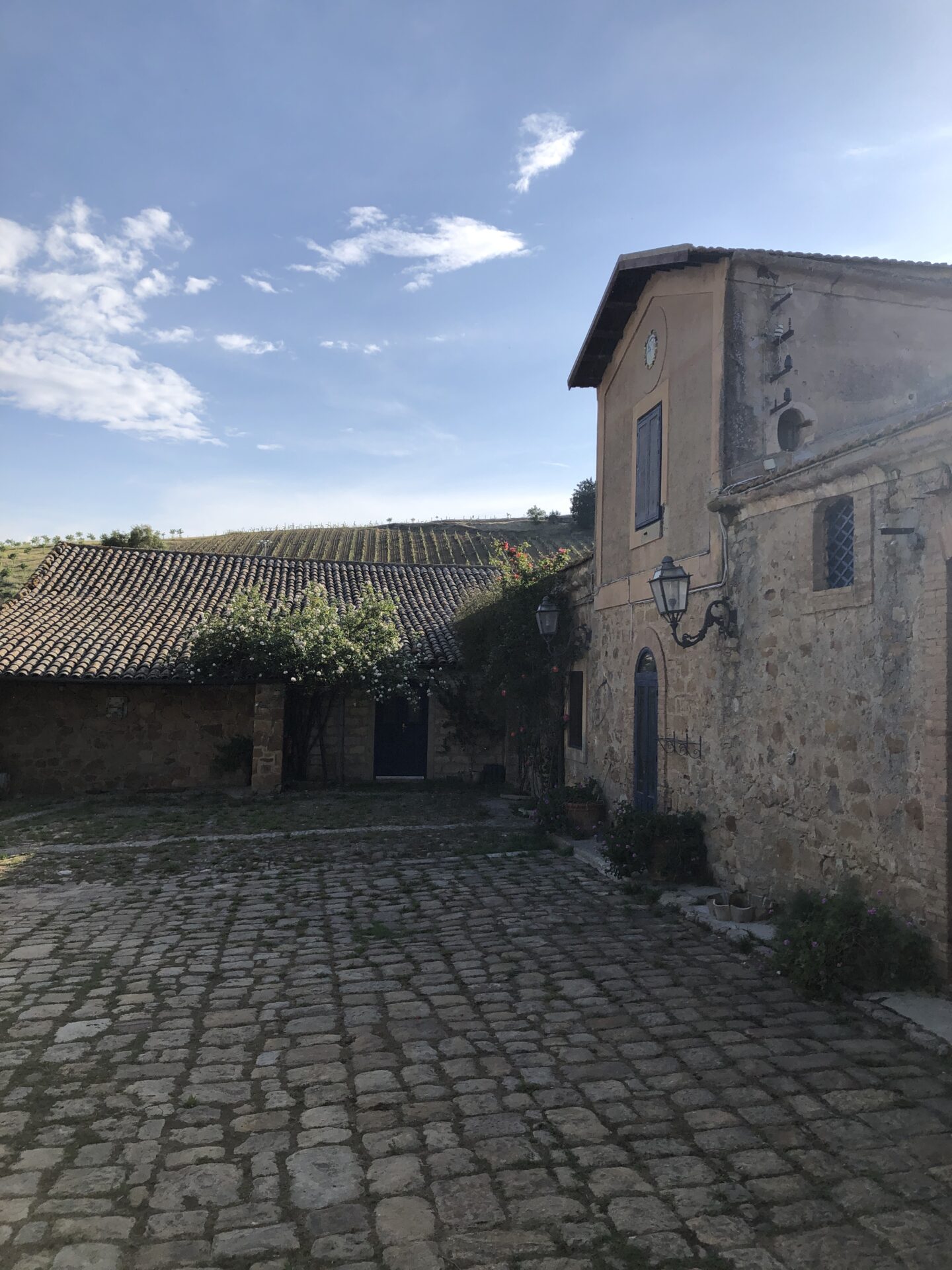
Speaking of these two cities — Ortigia and Palermo — has taken so much time that there isn’t enough left to speak to you about Regaleali. Enough, perhaps, to ask you to imagine a beautiful countryside of rolling hills. Being in the rural interior of Sicily is very different than being in a busy coastal city. Everywhere, a rich green except for the expanses of red poppies or of pink sulla or violet and pink flowers of wild peas. Everywhere, birdsong, the crowing of roosters, the cooing of doves, often the sound of the bells of far-off churches, sometimes the sound of the much smaller bells of sheep. Everywhere, row on row of grapevines. A farmhouse and its outbuildings enclosing a large courytyard which we entered through a huge wrought-iron gate. . . and where I and twelve other women sketched together admiring the beauty around us . . . and tried to capture a little bit of it in our sketchbooks. And where we cooked and ate well, the food that came from the earth that surrounded us.
And I closed by saying Grazie per aver ascoltando — Thanks for listening! Or, in this case, for reading. Re-reading this before I click “Publish,” I notice (with some discomfort, to be honest) that my English translation of an oral presentation in Italian is more awkward, in spots, than I’d like. Punctuation looser, syntax strained. None of the accompanying gestures or meaningful/dramatic pauses or rising or falling voice that makes an in-person presentation work. Still, I appreciate being able to share la mia voce Italiana with you, my Italian voice. Francesca’s. And I welcome any comments below, come sempre (as always).
Un abbraccio,
Frances(ca)
And for anyone who might be curious about Françoise, who speaks in my French voice, here’s a presentation I gave in the French class I took back in early 2020.
Molto interssante! Grazie, Francesca.
Author
Prego!
Brava !! I’m so impressed !!
Author
Grazie!
A wonderful post Frances . It brought back my memories of Italy very vividly , the scents , the sounds , the good & the bad . Our first foreign trip was to Italy , Capri & Naples , fifty years ago . It was a cheap country to visit in those days & it was all magical . Especially the Italians – the lovely guide at Herculaneum giving us a free tour when we explained we had no money to pay ( we had lots of enthusiasm though ) -the friendly locals teaching us how to eat spaghetti ( we were experts after that ) And I’ll never forget my first Italian ice cream !
Author
I envy you those early memories! I know nostalgia is dangerous (as we agreed last post), but travel was so much less filtered or curated then (my own travel in the 60s and 70s limited to visiting relatives in the UK). . . .
Oh, that ice cream. . .
Si, grazie, cara Francesa per questa storia in italiano. Mi piace! E un buon esercizio in una lingua straniera per una mattina. (Heh, forgive any errors in that, a very quick dashed-off bit of chatter.)
Thank you so much for formatting that way…I was quite caught up both in your story and my anticipation of how your English translation would compare with mine. And I do agree with what you are saying: that you are speaking in your Italian voice, which is not the same as your English voice, and then translating. You’re a different person in a different language aren’t you?
I find the stories of Falcone and Borsellino very moving so I was ‘primed’ emotionally when I reached the photo of the Bar Histo which captured why I so love travel…there is someone far away, who I will never know, who loves pink linens as I do. 🙂
ps I am eager to learn more about Sindaco Orlando…I am reading The Invention of Sicily but am still in Early Modern Times…I will meet him in about 500 years…
Author
Prego, è stato un piacere. I’m glad to know the formatting worked for you and happy to have someone reading my Italian self, who is, yes, a slightly different person than my English-speaking one.
Yes, to your 3rd paragraph. . . yes . . .
Sadly, Sindaco Orlando has been replaced after a long, long progressive run during which he made so many positive changes. The new mayor is only just elected, Roberto Lagalla, from a party he formed, I believe, on the centre right. . .
Thank you for transporting me to Sicily. Being able to write such a complex presentation in Italian confirms your proficiency in the language. When I studied French at school I remember needing to compose oral presentations by writing some text in English and then labouring to translate it into French – not good practice I know, but it was the only way I could get the job done. No surprise that my French language skills didn’t progress much. The island town of Ortigia sounds intriguing and I will search for photos and maps to learn more.
Author
Thanks, Maria — I try to write in Italian, but I must be honest and tell you that there is often consultation with my dictionary or my grammar text and even Google translate comes into the picture occasionally. . . But I’m trusting that the more I do (and this includes listening to podcasts and reading books and social media and news articles and talking to my classmates . . . and preparing oral presentations), the more I absorb so that if I were to live long enough, perhaps some day I wouldn’t have to process so deliberately 😉
Perfetto, cara Francesca! I’m so impressed-your italian is absolutely perfect! And the story so interesting! You are the best!
Dottoressa
Author
Grazie, K! And you’re very kind — it’s far from perfect (and my teacher has helped with needed corrections), but it’s very cool to be able to express this much in another language. As you well know! 😉
WOW! I so enjoyed your presentation (the English version). Thank you for the virtual glimpse into Sicily through your eyes.
Author
Thanks, and you’re very welcome!
Thank you! I really enjoyed seeing this glimpse of Sicily. I had to go straight to the English but can imagine how beautifully you delivered this in Italian. A very evocative post.
Author
So pleased you enjoyed it, Genevieve. Thanks for the kind words.
I will probably never have the opportunity to travel to Sicily but your presentation has given me a taste of what it might be like to be there. beautifully done. I was intrigued by your mention of the sculpture “The Pack” As one who does volunteer work with dogs I was moved by the idea of just their innate intelligence, their loving and compassionate doggie nature seen as an antidote to evil. Thank you.
Author
I’m hoping to do a post later on that installation — it’s very thought-provoking and the dog sculptures are SO good!
Sounds like a wonderful trip, Frances. I am so impressed by your commitment to learning Italian. I must admit to being envious as I read. Travel seems so far into the future for us.
Author
Sue, right now “Just Stay Home” once again seems like a good idea, more because of those scenes at the airports than from fear of illness!!
Many thanks, Francesca – I look forward to future posts from you (both!)!
Author
Francesca says “You’re welcome!” 😉
Thanks for sharing your presentation. It was a great introduction to these Sicilian towns. I went straight to the English and thoroughly enjoyed your writing. I would have loved to hear you speak the Italian presentation, even though I know only a few words of Italian. I am imagining the cadence and your voice as you describe your adventures. Maybe one day, you’ll have to share an audio clip of you speaking Italian.
Author
Ah, but then I’d really have to muster some bravery! 😉
Grazie tanto!
I really enjoyed your blog.Forty years ago I lived close to Quattro Canti and walked along Via Maqueda to work every day.Your blog brought back many memories for me…..and reminded me how kind the people were to a young,Scottish girl living abroad for the first time.
Author
Oh, I’m so pleased to read this! We stayed within a few blocks of Quattro Canti — I’m rather envious you walked that route daily and curious about how much it will have changed in the decades since. Judging by the home-cooked offerings brought to us regularly by the mother of the AirBnB host, kindness is still very evident!
That was jolly good. I hope you got top marks. And yes, making the effort to speak in a different language often garners a grateful and generous result. I like the idea of dipping brioche in granita very much indeed.
I enjoyed your presentation very much. I particularly admire your mastering of the congiuntivo, something I am still struggling with. Isn’t it a pity that Leoluca Orlando has had to step down?
Author
Thank you! And you should know that I am from from mastering the congiuntivo! This presentation relied a fair bit on consultations with dictionary and grammar text and, finally, some helpful copy-editing by my teacher.
Yes, such a shame to see Orlando replaced — we need more examples of progressive leaders who effect positive changes aimed at social justice.